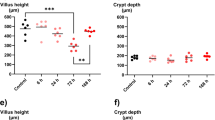Abstract
To examine the trophic effect of epidermal growth factor on the rat small intestine, we measured diamine oxidase and ornithine decarboxylase activities in intestinal mucosa injured by methotrexate. Methotreaate was infused orally via a gastric tube at a dose of 10 mg/kg per day on 3 successive days (days 1–3). Epidermal growth factor was injected intraperitoneally at a dose of 40 μg/kg per day on 4 successive days following methotrexate infusion (days 4–7). Methotrexate caused a marked decrease in diamine oxidase activity; this decrease returned to a normal level on day 13 in controls. In rats injected with epidermal growth factor, diamine oxidase activity began to recover earlier than in the controls, and returned to a normal level on day 11. Epidermal growth factor enhanced the increase of ornithine decarboxylase activity in mucosa injured by methotrexate. When the increase of ornithine decarboxylase activity was suppressed by α-difluoromethylornithine, epidermal growth factor failed to facilitate the repair of intestinal mucosa. These results indicate that epidermal growth factor enhances intestinal repair following methotrexate infusion, and that this effect is mediated, at least in part, by ornithine decarboxylase. It is proposed that epidermal growth factor can be used clinically as a means to enhance mucosal repair of the intestine after chemotherapy with methotrexate.
Similar content being viewed by others
References
Johnson LR. Regulation of gastrointestinal mucosal growth. Physiol Rev 1988;68:456–502.
Tabor CW, Tabor H. Polyamines. Ann Rev Biochem 1984;53:749–790.
Wang, JY, Johnson LR. Polyamines and ornithine decarboxylase during repair of duodenal mucosa after stress in rat. Gastroenterology 1991;100:333–343.
Luk GD, Martin LJ, Baylin SB. Ornithine decarboxylase is important in intestinal mucosal maturation and recovery from injury in rats. Science 1980;210:195–198.
Chung DH, Evers BM Townsend CM Jr, et al. Role of polyamine biosynthesis during gut mucosal adaptation after burn inury. Am J Surg 1993;165:144–149.
Fujimoto K, Granger DN, Price VH, Tso P. Ornithine decarboxylase is involved in repair of small intestine after ischemia-reperfusion in rats. Am J Physiol 1991;261:G523-G529.
Konturek SJ, Brzozowski T, Plastucki I, et al. Role of mucosal prostaglandins and DNA synthesis in gastric cytoprotection by luminal epidermal growth factor. Gut 1981;22:927–932.
Britton JR, Nascimento CG, Koldovsky O. Luminal hydrolysis of recombinant human epidermal growth factor in the rat gastrointestinal tract: Segmental and developmental differences. Life Sci 1988;43:1339–1347.
Iton M, Joh T, Imai S, et al. Experimental and clinical studies on epidermal growth factor for gastric mucosal protection and healing of gastric ulcers. J Clin Gastroenterol 1988;10(Suppl):S7-S12.
Feldman EJ, Aures D, Grossman MI. Epidermal growth factor stimulates ornithine decaboxylase activity in the digestive tract of mucosa. Proc Soc Exp Biol Med 1987;159: 400–402.
Ulshen MH, Lyn-Cook L, Raasch RH. Effects of intraluminal epidermal growth factor on mucosal proliferation in the small intestine of adult rats. Gastroenterology 1986;91: 1134–1140.
Goodlad RA, Gregory H, Wright NA. Is polyamine synthesis involved in the proliferative response of the intestinal epithelium to urogastrone-epidermal growth factor? Clin Sci 1989;97:595–598.
Fitzpatrick LR, Wang P, Johnson LR. Effect of epidermal growth factor on polyamine-synthesizing enzymes in rat enterocytes. Am J Physiol 1987;252:G209-G214.
Dembinski A, Gregory H, Konturek SJ, Polanski M. Trophic action of epidermal growth factor on the pancreas and gastroduodenal mucosa in rats. J Physiol 1982;325:35–42.
Goodlad RA, Raja KB, Wright NA. Effect of urogastrone-epidermal growth factor on intestinal brush border enzymes and mitotic activity. Gut 1991;32:994–998.
Bamba T, Tsujikawa T, Hosoda S. Effect of epidermal growth factor by differential route of administration on the small intestinal mucosa of rats fed elemental diet. Gastroenterol Jpn 1993;28:511–517.
Calabresi P, Chabner BA. Chemotherapy of neoplastic diseases. In: Gilman AG, Rall TW, Nies AS, Taylor P (eds) The pharmacological basis of therapeutics. 8th ed. New York: Pergamon, 1990;1202–1263.
Fujimoto K, Sakata T, Shiraishi T, et al. Anorexia induced in rat by D-glucosamine deoxidized at C-1. Am J Physiol 1986; 251:R481-R491.
Kusche J, Lorenz W. Diamine oxidase. In: Bergmeyer HU (ed) Methods of enzymatic analysis. Vol. 3. 3rd ed. Weinheim: VCH, 1983;237–250.
Winer BJ. Statistical principles in experimental design. 2nd ed. New York: McGraw-Hill, 1971.
Baylin SB, Stevens SA, Shakir KMM. Association of diamine oxidase and ornithine decarboxylase with maturing cells in rapidly proliferating epithelium. Biochem Biophys Acta 1978; 541;415–419.
Luk GD, Bayless TM, Baylin SB. Diamine oxidase (histaminase), a circulating marker for rat intestinal mucosal maturation and integrity. J Clin Invest 1980;56:66–70.
Carpenter G, Cohen S. Epidermal growth factor. Annu Rev Biochem 1979;48:193–216.
Macro ED, Piece JH, Adronson SA, DiFiore PP. Mechanisms by which EGF receptor and TGFα contribute to malignant transformation. Nat Immun Cell Growth Regul 1990;9:209–221.
Yasui W, Takekura N, Kameda T, et al. Effect of epidermal growth factor on rat stomach carcinogenesis induced by N-methyl-N′-nitro-N-nitrosoguanidine. Acta Pathol Jpn 1990;40:165–171.
Pain B, Woods CM, Saez J, et al. EGF-R as a hemopoietic growth factor receptor: the c-erbB product is present in chicken erythrocytic progenitors and controls their self-renewal. Cell 1991;65:37–46.
Author information
Authors and Affiliations
Rights and permissions
About this article
Cite this article
Hirano, M., Iwakiri, R., Fujimoto, K. et al. Epidermal growth factor enhances repair of rat intestinal mucosa damaged by oral administration of methotrexate. J Gastroenterol 30, 169–176 (1995). https://doi.org/10.1007/BF02348661
Received:
Accepted:
Issue Date:
DOI: https://doi.org/10.1007/BF02348661




